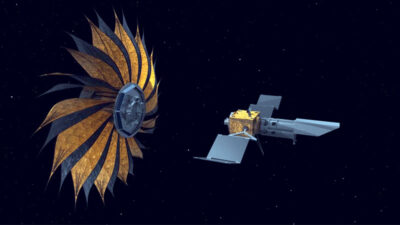Predicting, reducing noise from supersonic jets and unmanned aircraft
By NATHAN E. MURRAY|December 2018
The Aeroacoustics Technical Committee addresses the noise produced by the motion of fluids and bodies in the atmosphere and the responses of humans and structures to this noise.
The rollout of unmanned air vehicles into daily life is underway, and the aeroacoustics community is working to ensure that noise does not become a barrier to developments for unmanned air systems, or UAS. In April, Virginia Tech opened the tallest netted drone park in the United States. At 85-feet tall, 300-feet long and 120-feet wide, the park will be used for research in small UAS operations. In August, Uber Elevate, U.S. Army Research Labs and the University of Texas at Austin launched a collaborative effort to explore the efficiency and noise signature of stacked co-rotating rotors for vehicle concepts at Uber Air, Uber’s proposed urban aviation ride-share network.
The International Civil Aviation Organization, or ICAO, anticipates the certification of a new supersonic airplane for overland flight in the 2020-2025 timeframe. This year, NASA conducted independent noise predictions using its Aircraft Noise Prediction Program code to support ICAO’s Working Group 1 in evaluating landing/takeoff noise for a supersonic transport conceptual aircraft. The studies included advanced takeoff procedures to determine potential benefits for reducing community noise. In May, NASA completed a three-year effort to assess sonic booms in atmospheric turbulence, or SonicBAT, involving flight experiments at NASA’s Armstrong Flight Research Center in California and the Kennedy Space Center in Florida. The data were used to develop prediction algorithms for the loudness of sonic booms from modern low-boom aircraft designs. The SonicBAT team, led by Wyle Laboratories, included Pennsylvania State University, Lockheed Martin, Gulfstream Aerospace, Boeing, Eagle Aeronautics and the France-based Fluid Mechanics and Acoustics Laboratory.
Jet noise reduction efforts focused on the application of noise reduction strategies to high-performance or future complex jet propulsion. In March, the Discovery Channel’s Daily Planet teamed with the University of Mississippi, University of Texas at Austin and CRAFT Tech Inc. to film a documentary on jet noise as part of an ongoing campaign to tell the public about the achievements being made to reduce supersonic jet noise for tactical aircraft. In April, the Office of Naval Research and Naval Air Systems Command co-hosted a workshop on turbulence, wavepackets and jet noise at the California Institute of Technology. The workshop signified the community’s maturation of a number of theoretical tools such as resolvent analysis, adjoint-based sensitivity, and advanced source localization techniques. The workshop sought to define a path toward enhanced passive and active noise reduction by fully utilizing powerful large-eddy simulations and state-of-the-art laboratory diagnostics. In May, researchers from Syracuse University, Ohio State University and Spectral Energies LLC, with support from NASA and the Air Force Office of Scientific Research, completed the simulation, measurement and validation of a complementary computational and experimental data set for a supersonic multistream single-expansion ramp nozzle flow. The measurements and simulation were constructed so that 1-to-1 comparisons could be used to converge higher-order statistical information relevant to the details of jet noise production when a supersonic jet skims over a portion of the fuselage.
NASA prepared for the 2019 launch of the Space Launch System, or SLS, the most powerful rocket NASA has built, and the correct determination of the vibroacoustic environment is key to the success of the mission. In mid-2018, researchers at NASA’s Marshall Space Flight Center in Alabama and the University of Texas at Austin completed a series of tests for determining the acoustic geometric attenuation factor for hydrogen vapor cloud explosions, a significant component for a refined estimate of the vibroacoustic loads that form on the launch pad during the SLS liftoff. More testing of this type will continue in 2019.
Contributors: Cliff Brown, Dom Maglieri, Nathan Alexander, Mark Glauser and Charles Tinney
Editor’s note: Nathan Murray is an employee of the University of Mississippi.
Photo: Virginia Tech opened the tallest netted drone park in the United States for research in small unmanned aircraft operations. Credit: Virginia Tech



































